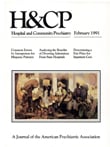A Biobehavioral Model for Hospital Psychiatry in an Era of Increasing Regulation and Cost Containment
Abstract
Psychiatric hospitalization is increasingly a target of cost reduction by employers and third-party payers. The authors describe an evaluation of a biobebavioral model for the treatment of a mixed population of public - and privatesector patients in the psychiatric unit of a general hospital under conditions of severe regulation and cost containment. The program combined behavioral-education technology based on principles of social reinforcement with the traditional medical model in which be psychiatrist specified the patient's individual treatment within the general programmatic framework. Patient progress was monitored using standardized clinic rating scales, which showed that between 85 and 96 percent of the patients bad improved significantly at discharge after an average stay of 12 days. Basedon that and other findings, the authors believe that the new programmatic technology of biobebavioral psychiatry has the flexibility to ameliorate the adverse effects of increasing regulation and cost containment, even under demanding clinical conditions.
Access content
To read the fulltext, please use one of the options below to sign in or purchase access.- Personal login
- Institutional Login
- Sign in via OpenAthens
- Register for access
-
Please login/register if you wish to pair your device and check access availability.
Not a subscriber?
PsychiatryOnline subscription options offer access to the DSM-5 library, books, journals, CME, and patient resources. This all-in-one virtual library provides psychiatrists and mental health professionals with key resources for diagnosis, treatment, research, and professional development.
Need more help? PsychiatryOnline Customer Service may be reached by emailing [email protected] or by calling 800-368-5777 (in the U.S.) or 703-907-7322 (outside the U.S.).



